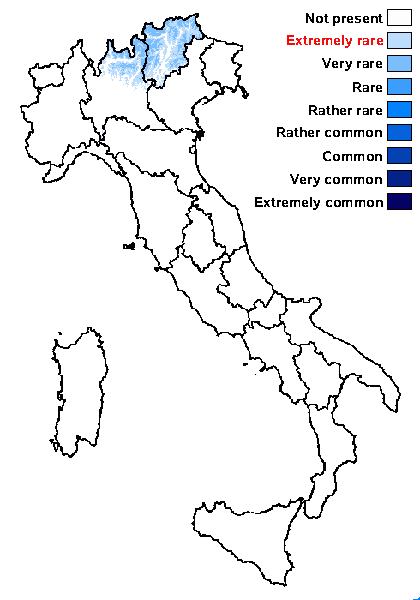Polyblastia forana (Anzi) Arnold
Flora, 45: 56, 1862. Basionym: Thelotrema foranum Anzi - Cat. Lich. Sondr.: 105, 1860.
Synonyms: Verrucaria forana (Anzi) Nyl.; Verrucaria pallidelutea Garov.
Distribution: N - TAA, Lomb.
Description: Thallus crustose, endosubstratic, continuous, pale grey, often poorly evident. Perithecia black, globose, 0.15-0.2 mm across, half immersed, leaving pits in the rock when they fall out. Involucrellum rather thick, dimidiate; exciple dark throughout; hamathecium of periphyses and periphysoids, interascal filaments absent; hymenial gel hemiamyloid, I+ red (I+ blue at very low concentrations of I), K/I+ blue. Asci 8-spored, clavate, K/I–, fissitunicate, the wall thickened above, with an ocular chamber, dehiscent by extrusion of an endotunica to form a delicate rostrum. Ascospores submuriform, with 3-4 transverse septa and (0-)1-2 longitudinal septa, hyaline, ellipsoid, with rounded ends, 21-27 x 10-14 μm. Photobiont chlorococcoid. Spot tests: K-, C-, KC-, P-, UV-. Chemistry: without lichen substances.Note: this rarely collected lichen growing on calcareous pebbles in upland areas is worthy of further study.
Growth form: Crustose endolithic
Substrata: rocks
Photobiont: green algae other than Trentepohlia
Reproductive strategy: mainly sexual
Poorly known taxon in need of further study
Commonnes-rarity: (info)
Alpine belt: very rare
Subalpine belt: extremely rare
Oromediterranean belt: absent
Montane belt: extremely rare
Submediterranean belt: absent
Padanian area: absent
Humid submediterranean belt: absent
Humid mediterranean belt: absent
Dry mediterranean belt: absent

Predictive model
Growth form: Crustose endolithic
Substrata: rocks
Photobiont: green algae other than Trentepohlia
Reproductive strategy: mainly sexual
Poorly known taxon in need of further study
Commonnes-rarity: (info)
Alpine belt: very rare
Subalpine belt: extremely rare
Oromediterranean belt: absent
Montane belt: extremely rare
Submediterranean belt: absent
Padanian area: absent
Humid submediterranean belt: absent
Humid mediterranean belt: absent
Dry mediterranean belt: absent

Predictive model
 Index Fungorum
Index Fungorum
 GBIF
GBIF

